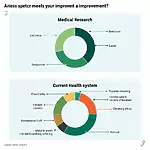The topic of diverse work environments is a recurring theme in IELTS Writing Task 2, appearing with moderate frequency in recent years. Its relevance to modern workplaces and global business trends suggests it may continue to be a popular subject for examination. Based on past trends, we can expect questions related to this topic to focus on the benefits and challenges of workplace diversity, strategies for fostering inclusive environments, or the impact of diversity on organizational performance.
Let’s examine a recent IELTS Writing Task 2 question that aligns closely with this theme:
Some people think that employers should not care about the way their employees dress, because what matters is the quality of their work. To what extent do you agree or disagree?
Analysis of the Question
This question touches on the broader theme of workplace diversity by addressing dress codes and personal expression in professional settings. It requires candidates to consider the balance between individual freedom and professional standards, which is a key aspect of managing diverse work environments.
Key points to consider:
- The importance of work quality vs. appearance
- The impact of dress on workplace culture and client perceptions
- Cultural and personal expressions through clothing
- Potential benefits and drawbacks of dress codes
Sample Essay 1 (Band 8-9)
In today’s increasingly diverse workplace, the debate over employee dress codes has gained significant attention. While some argue that the quality of work should be the sole focus for employers, I partially disagree with this view. I believe that while work quality is paramount, the way employees dress can also play a crucial role in fostering a positive and professional work environment.
Undoubtedly, the primary concern for any employer should be the caliber of work produced by their employees. Skills, knowledge, and productivity are the cornerstones of professional success, and these attributes are not necessarily reflected in one’s attire. A brilliantly creative designer or a highly efficient programmer may prefer casual clothing that allows them to feel comfortable and focus on their tasks. In such cases, enforcing strict dress codes might even hinder productivity and creativity.
However, it would be shortsighted to completely disregard the impact of employee appearance in the workplace. Clothing choices can significantly influence perceptions, both internally among colleagues and externally with clients or customers. In client-facing roles, for instance, a polished appearance can inspire confidence and professionalism, potentially affecting business relationships and outcomes. Moreover, a certain level of dress standards can contribute to a sense of unity and shared purpose within an organization.
The effects of cultural diversity on workplace dynamics extend to dress codes as well. In diverse work environments, clothing can be a form of cultural expression. Employers should strive to balance respect for individual and cultural identities with the need for a cohesive professional image. This might involve flexible dress codes that accommodate various cultural practices while maintaining a general standard of professionalism.
 Balancing diversity and professionalism in workplace attire
Balancing diversity and professionalism in workplace attire
In conclusion, while the quality of work should indeed be the primary focus for employers, the importance of employee dress should not be entirely dismissed. A balanced approach that prioritizes work quality while maintaining reasonable dress standards can contribute to a positive, inclusive, and professional work environment. This nuanced perspective acknowledges the complexities of modern diverse workplaces and the multifaceted nature of professional success.
(Word count: 398)
Sample Essay 2 (Band 6-7)
In the modern workplace, there is a debate about whether employers should care about how their employees dress or just focus on the quality of their work. In my opinion, I somewhat agree that work quality is more important, but I also think that how employees dress matters to some extent.
Firstly, it’s true that the most important thing in any job is how well someone does their work. If an employee is very skilled and produces excellent results, this should be valued more than their appearance. For example, a software developer who creates amazing programs shouldn’t be judged on whether they wear a suit or casual clothes. Their coding skills are what really count.
However, I believe that appearance can still be important in some situations. In jobs where employees meet clients or represent the company to the public, how they dress can affect the company’s image. A smartly dressed salesperson, for instance, might make a better impression on customers than one who looks messy or unprofessional.
The importance of cultural awareness in global workplaces also relates to this issue. In some cultures, formal dress is expected in business settings, while in others, a more casual style is acceptable. Employers need to consider these cultural differences when thinking about dress codes.
Another point to consider is that having some basic dress standards can help create a professional atmosphere in the workplace. If everyone dresses in a way that’s appropriate for work, it can help people feel more focused and ready to do their jobs well.
In conclusion, while I agree that the quality of work should be the main priority for employers, I think that how employees dress still has some importance. A balanced approach, where good work is highly valued but there are also some reasonable expectations about appearance, seems like the best solution for most workplaces.
(Word count: 345)
Explanation of Band Scores
Band 8-9 Essay:
This essay demonstrates excellent writing skills and a sophisticated approach to the topic, warranting a high band score:
-
Task Achievement: The essay fully addresses all parts of the task, presenting a clear position with a balanced view. It explores multiple aspects of the issue, including work quality, client perceptions, and cultural considerations.
-
Coherence and Cohesion: The essay is well-organized with clear progression throughout. It uses a range of cohesive devices effectively, and each paragraph has a clear central topic.
-
Lexical Resource: The vocabulary used is sophisticated and precise, with natural and accurate use of less common lexical items. For example, “caliber of work,” “shortsighted,” “polished appearance.”
-
Grammatical Range and Accuracy: The essay demonstrates a wide range of grammatical structures used accurately and appropriately. Complex sentences are used effectively without errors that impede communication.
Band 6-7 Essay:
This essay shows good writing skills but lacks some of the sophistication of the higher band essay:
-
Task Achievement: The essay addresses the task, presenting a clear position. However, the ideas are less fully developed compared to the Band 8-9 essay.
-
Coherence and Cohesion: The essay is generally well-organized, but the use of cohesive devices is less sophisticated. Paragraphing is logical.
-
Lexical Resource: The vocabulary is appropriate and adequate for the task, but lacks the precision and sophistication of the higher band essay. There’s less use of uncommon lexical items.
-
Grammatical Range and Accuracy: The essay uses a mix of simple and complex sentence forms. There are no major grammatical errors, but the range is more limited compared to the Band 8-9 essay.
Key Vocabulary to Remember
- Diverse (adjective) /daɪˈvɜːrs/ – showing a great deal of variety; very different
- Foster (verb) /ˈfɒstə(r)/ – encourage or promote the development of something
- Caliber (noun) /ˈkælɪbə(r)/ – the quality of someone’s character or the level of their ability
- Perception (noun) /pəˈsepʃn/ – the way in which something is regarded, understood, or interpreted
- Cohesive (adjective) /kəʊˈhiːsɪv/ – characterized by or causing cohesion; unified
- Nuanced (adjective) /ˈnjuːɑːnst/ – characterized by subtle shades of meaning or expression
- Paramount (adjective) /ˈpærəmaʊnt/ – more important than anything else; supreme
- Multifaceted (adjective) /ˌmʌltiˈfæsɪtɪd/ – having many different aspects or features
The benefits of lifelong learning in the modern workforce include the ability to adapt to changing workplace norms and expectations, such as evolving dress codes and diversity policies.
In conclusion, the topic of diverse work environments, including aspects like dress codes, is likely to remain relevant in IELTS Writing Task 2. Candidates should be prepared to discuss various aspects of workplace diversity, including cultural considerations, professional standards, and the balance between individual expression and organizational norms. To practice, try writing your own essay on this topic or related themes such as:
- The impact of cultural diversity on team productivity
- The role of language diversity in global companies
- Strategies for promoting inclusivity in multinational corporations
Feel free to share your practice essays in the comments section for feedback and discussion. This active engagement will help you develop your writing skills and prepare effectively for the IELTS Writing Task 2.


